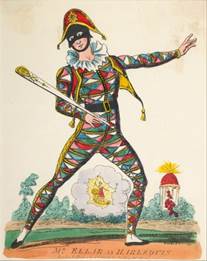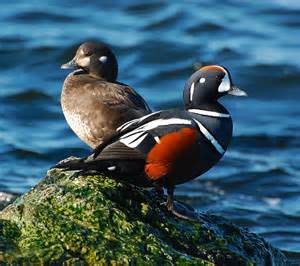His clothes had been made of some stuff that was brown holland probably, but it was covered with patches all over, with bright patches, blue, red, and yellow—patches on the back, patches on the front, patches on elbows, on knees; coloured binding around his jacket, scarlet edging at the bottom of his trousers; and the sunshine made him look extremely gay and wonderfully neat withal, because you could see how beautifully all this patching had been done. –description of “the harlequin’, the Russian who assists Kurtz in the Heart of Darkness, by Joseph Conrad.
Given that here in Seattle we broke the all-time October record rain in Seattle with 10.05 inches for the month – a duck for this week seems appropriate.
Harlequin ducks – named for their quite colorful plumage, can be found along fast-moving mountain streams during the spring-summer and migrate to the coast for the autumn-winter. Harlequin takes its name from a brightly dressed character in Commedia dell’arte , a form of theater of “masked types” in the late 16th century. Histrionicus – from the Latin histrio – meaning “actor”. These birds must generally prefer moving water because along the coast it is rare to find them in sheltered bays and they prefer open, rocky coastlines where waves pound on the rocks. It also is called the painted duck, totem pole duck, rock duck, and mountain duck, among others.

The males are colored quite bizarrely – as if an artist put his imagination at play. They are a deep blue-black with white markings on the head and sides, and a broad chestnut-colored patch on the flanks. Most of the white markings are edged in black, which enhance their contrast. Females and immature birds are uniformly black with three white spots on their head. The females resemble a female bufflehead, which has only one white spot on their head. They have a squeaky call you can listen to here: https://www.allaboutbirds.org/guide/Harlequin_Duck/sounds
Harlequins have a bisected – east and west range. The eastern range includes the upper east coast of North America (as far south as NJ), Greenland, and Iceland. The western range includes NE Siberia and the Kamchatka Peninsula, the Aleutian Islands, much of interior Alaska, and south to NW Wyoming and northern California. Estimates for them in the Aleutians range from 600,000 to 1 million birds – but this is likely an underestimate given the challenges of weather and conducting precise surveys.
The eastern population breeds in Iceland, Greenland, Baffin Island, and Labrador and has been dwindling. The western population is significantly larger and stable. Here in the PNW it is found in the Cascades during the breeding season along steep streams – but not at high densities. An estimated 100 pair breed in the Oregon Cascades and Wallowa Mountains and about 400 breed in WA. Groups of up to 50 have been observed along the WA and OR coast – particularly in the Strait of Juan de Fuca and near Tillamook. Larger numbers, up to 500 at a time, have been recorded along Vancouver Island.

Nests are simple structures of a thin layer of grass and a few dried twigs and leaves lined with down. An average of seven eggs are laid over several days and hatch in about 29 days. The young are escorted by the female but can immediately feed off the water surface and are soon diving in the adjacent fast-moving stream. They eat a variety of animals including crustaceans (57%), mollusks (25%), insects (10%), and echinoderms and fish at over 2% each. The remaining 4% of their diet was plant material. On the coast they eat a lot of chitons, which are mollusks that adhere to rocks – other birds apparently cannot pry them off the rocks, but the harlequins somehow manage this feat. https://www.youtube.com/watch?v=mItFHlIMwhc
In South America there is a species that displays similar traits – the torrent duck, which breeds along fast-moving mountain streams. But unlike the Harlequin duck, the torrent duck stays along these streams all year. This is a good example of convergent evolution – where two separate species develop a similar lifestyle, or niche, separately. Think of habitat as where an animal lives and niche as how it earns its living.
And in the case of harlequin ducks they display not only a bisected range (east-west), but individuals, on an annual basis, use distinctly different habitats (mountain streams and rocky coasts). So it takes a bit of energy to fly back and forth between these seasonal outposts, thus there must be some advantage to this behavior – it both cases (mountain streams and rocky shore) the harlequin is exploiting a niche, and food sources, not available to other species.
I’ve not seen harlequin ducks along their breeding streams, though I’m hopeful because we have several projects along Sullivan Creek, a tributary to the Pend Oreille River in extreme NE WA, where they are known to breed. Instead I’ve come across them on the WA coast several times out on the Olympic Peninsula. They seem to enjoy the windswept rocky shore and don’t mind hunting among the rocks and the swells. And in the gray winter, they are quite the striking bird if you are lucky enough to see one.
